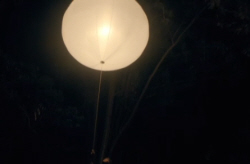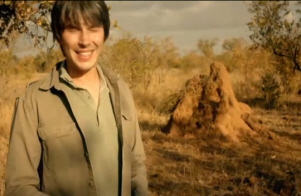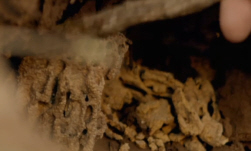Carbon Harvest – Termites and Fungus
From the universe’s earliest times, carbon has been created inside ageing stars. And over time, this carbon has built up, drifting through the cosmos as dust… until some of it was caught up in the formation of a planet called Earth. And it’s here that we can see this ancient carbon brought vividly to life. This carbon harvest is crucial to all life on our planet.

Today, the universe is old enough that countless stars have lived and died.
So, there’s been plenty of time to synthesise the primordial hydrogen and helium into the heavy elements. The question now is, how does that carbon get into the web of life?
Well, today, it enters via one ingredient and I’m going to measure it using this balloon. The ingredient is carbon dioxide, which plays a key role in photosynthesis. Each night the carbon dioxide concentration increases, filling the air around the leaves at the top of the trees. This balloon has a carbon dioxide monitor in it which is going to measure the change in the levels of CO2 at the top of the Forest canopy as night turns to day.
The Process of Photosynthesis

As the sun rises, the trees begin to photosynthesise. At 6 PM last night, just after sunset, the concentration was around 350 parts per million. Around 10 PM, around four hours after sunset, the concentration had risen to about 400 parts per million. Now, at about midday, the concentration’s back down to about 345 ppm.
So that’s a variation over a period of about eighteen hours of 10% in the concentration of carbon dioxide, just in that piece of atmosphere at the top of the Forest canopy . what you are seeing there is photosynthesis in action.
Every day, across the planet, photosynthesis uses sunlight to turn carbon dioxide and water into simple sugars. The overwhelming majority of the carbon is locked up inside long chains of sugar molecules called cellulose and lignin. Lignin is the stuff which gives Wood its strength. So, in this form, remember, that is most of it, is very difficult indeed for animals to access.
The World of Termites

For the energy and nutrients locked away in these long carbon chains to move through the food web, they must be broken down. And the best place to see that process in action is out on the open plain. It’s one vast larder for all manner of organisms. But by far the most effective harvester of carbon is actually one of the smallest creatures on the Savannah. Termites are social insects, working together to form a characteristic sight seen all over the bush.
That’s a termite mound. Actually, it’s the tip of the iceberg. The termite city extends way beyond that underground. And its function is fascinating. It’s essentially an air-conditioning system. What it does is maintain specific conditions inside the mound – the conditions of the rainforest. When the termites first colonised the Savannah 30 million years ago, they brought the rainforest with them to support the form of life that was already wonderfully adapted to living off dead wood.
This is what these termite mounds are all about. Can you see those structures, those white honeycomb-like structures? Those are called fungal combs. They are wood pulp and possibly bits of dead grass that the termites bring in and build into that structure. And the reason the conditions have to be the same as the rainforest is because they grow a particular genus of fungus called termitomyces around those honeycombs.

The job of that fungus is to break down the lignin and cellulose inside the wood and convert it into a form that the termites can eat, which you can see there, the little white nodules, just present on the honeycomb structure.
The termites lack the enzymes to break down the wood efficiently, so they have become farmers, tending to one giant social stomach. So there is a very intense relationship between the termites and the fungus. You don’t find that fungus anywhere else in the world, as far as we know, other than inside termite mounds. It’s thought that up to 90% of the carbon locked up in lignin in this part of Africa is released back into the food chain again, solely by those termites and that fungus.
External Links
Carbon Harvest on a Commercial Scale –Harvesting the Environment
